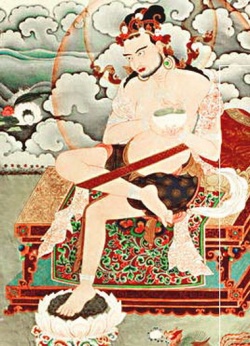The Practice of the Visualization of the Stong-ra (the Empty Body)
The Yogi should visualize the image of the patron Buddha as before, but now he should especially visualize the interior of the body as clear and transparent, like crystal, from the top of the head to the soles of the feet.
In this manner, the yogi should try to stabilize the visualization.
The practice of mental visualization and the physical exercises should be carried out alternatively.
The Stong-ra practice is to visualize the body without the slightest shadow or obstruction as if one were seeing a clear rainbow.
Although one's body cannot at this stage actually become (a body of rainbow), the stabilization of this visualization will enable the yogi to overcome the hazards—the nerve pains and prana pains—which he may encounter during his practice.
Because of this Stong-ra practice, the greater pains or hazards will not arise; even if these pains do arise they can be subdued by the practice of Stong-ra visualization.
This is the special advantage of practicing Stong-ra as well as the physical exercises.
Although there are a number of different statements and arrangements of the Stong-ra practice, the teaching of Pag-mo-grub-b’a says no more than the instruction given above; therefore, one should know that to follow this instruction is quite sufficient.
Though one may not find many accounts of the Stong-ra and physical exercises in the main Tantras, these are the pith-instructions taught by the masters.
Furthermore, in the practice on Rtsa56 and prana it is sometimes difficult to attain Samadhi through the gentle or soft practice; therefore, the radical or strong practice is needed.
In that case it is believed that these preparatory practices will minimize hazards and obstacles.
